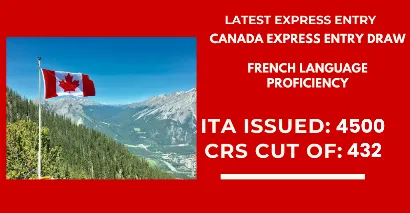Key Highlights
- Highlights
- Understanding Express Entry Draw 371
- CRS Score Requirements and Comparison.
- Eligibility Criteria for French Language Category
- French Language Testing Requirements
- Canada's Francophone Immigration Strategy
- 2025-2027 Francophone Immigration Targets
- Benefits for French-Speaking Candidates
- Quebec v. Federal Immigration Pathways
- Provincial Francophone Immigration Programs
- Next Steps for Invited Candidates
- Conclusion
In Express Entry Draw 371 on October 6, 2025, Canada issued 4,500 Invitations to Apply (ITAs) to candidates who are proficient in French. The Comprehensive Ranking System (CRS) draw was reduced to 432, a major decrease of 14 points as opposed to the last French-language draw that was conducted on September 4, 2025. This type of selection by categories highlights the importance of Immigration, Refugees and Citizenship Canada to recruit skilled Francophone immigrants who are not in Quebec.
The Express Entry Draw 371 is a significant chance for French-speaking skilled employees who would like to reside in Canada on a permanent basis. The candidates who participated in the October 6 draw were candidates who had proved themselves as good in the French language based on approved testing. This draw had one of the lowest entry thresholds of 2025 to category-based selections, with a CRS score of only 432. This is observed by the immigration experts as a sign that Canada has been strategic in enhancing the Francophone community in the non-Quebec provinces and also focusing on the labor market demands.
Highlights
-
October 6, 2025: IRCC conducted Express Entry Draw 371, issuing 4,500 ITAs exclusively to French-speaking candidates with a minimum CRS score of 432
-
CRS Score Drop: The cutoff decreased by 14 points from the previous French proficiency draw (446 points on September 4), making qualification easier
-
Category Focus: This marked the second Express Entry draw in October 2025, following a Canadian Experience Class draw on October 1 that required 534 CRS points
-
2025 Pattern: French language draws have consistently featured lower CRS requirements compared to general draws, with scores ranging from 379 to 481 throughout the year
Understanding Express Entry Draw 371
Express Entry draw 371, in particular, was targeting those candidates who are able to satisfy the requirements of the category-based system of selection in Canada regarding the French language proficiency. Immigration officers focused on people who showed good skills in French to help the government achieve its Francophone immigration plan of 2025-2027.
The tie-breaking provision regarding this draw applied to the candidates who completed their Express Entry profiles prior to a certain deadline and time. When two or more candidates have the same CRS score, IRCC considers the date and time in which the profile is submitted so that the person invited is the one who has the latest date and time.
CRS Score Requirements and Comparison.
And the lowest CRS score of 432 on Draw 371 is a competitive advantage to the French-speaking candidates. General Express Entry attracts and Provincial Nominee Program attracts selections that usually need very high marks, which are usually more than 700 points.
|
Draw Type |
Recent CRS Score |
Date |
ITAs Issued |
|
French Language Proficiency (Draw 371) |
432 |
October 6, 2025 |
4,500 |
|
Canadian Experience Class (Draw 370) |
534 |
October 1, 2025 |
1,000 |
|
Provincial Nominee (Draw 369) |
855 |
September 29, 2025 |
291 |
|
French Language Proficiency (Draw 365) |
446 |
September 4, 2025 |
4,500 |
Eligibility Criteria for French Language Category
To qualify under the French language proficiency draws, under Express Entry, the applicants have to meet certain requirements. The applicants have to score NCLC 7 (Niveaux de competence linguistique canadiens) in all four language skills: reading, writing, listening, and speaking.
Knowledge of the French language should be proven through recognized testing agencies by the IRCC. Also, a candidate should be eligible under one of the three federal economic immigration programs, which include: Federal Skilled Worker Program (FSWP), Federal Skilled Trades Program (FSTP), or Canadian Experience Class (CEC).
Bilingual applicants who have acquired proficiency in both French and English may receive full points on the CRS, which will go a long way in increasing their invitations. The Express Entry programme gives bonus points based on good knowledge of a second language, especially when the first language is French.
French Language Testing Requirements
|
Language Skill |
Minimum NCLC Level |
Equivalent TEF Canada Score |
|
Reading |
NCLC 7 |
207-232 |
|
Writing |
NCLC 7 |
310-348 |
|
Listening |
NCLC 7 |
249-279 |
|
Speaking |
NCLC 7 |
310-348 |
Canada's Francophone Immigration Strategy
In 2025, IRCC will give French-speaking immigration a priority, with numerous category-based draws at reduced CRS requirements. The government aims to raise the percentage of French-speaking permanent residents not in Quebec to 8.5 percent in 2025 and 10 percent in 2027.
This is a strategic focus, which will serve a demographic purpose and assist the Francophone minority communities in all of the Canadian provinces. There is federal funding of $9.3 million used to improve the settlement services and the Francophone community organizations.
French-speaking New French speakers on Express Entry draws have always had lower CRS cutoffs than general draws. During the period of February to October 2025, the proficiency in the French language attracted between 379 and 481 CRS points, whereas the general and Provincial Nominee draws were over 500 points.
2025-2027 Francophone Immigration Targets
|
Year |
Target Admissions |
Percentage of Total Immigration |
|
2025 |
29,325 |
8.50% |
|
2026 |
31,350 |
9.50% |
|
2027 |
31,500 |
10.00% |
Benefits for French-Speaking Candidates
The knowledge of the French language has significant benefits in the Express Entry system. Applicants who speak good French have reduced CRS cutoffs on category-based draws, and permanent residence is increasingly available.
Express Entry CRS computation gives extra points to bilingual immigrants who have mastered both English and French. This bonus will give up to 50 points to an individual candidate, which will greatly enhance competitiveness.
French-speaking immigrants are also enjoying specific settlement services and communal supports all over Canada. Programs provided by federal and provincial agencies provide language training, employment support, and integration services exclusively to Francophone newcomers.
The employment prospects of bilingual professionals in government work, healthcare, education, and customer care have increased. Numerous employers in Canada are actively pursuing French-speaking talent to cater to a wide range of populations and venture into Quebec markets.
Quebec v. Federal Immigration Pathways
Quebec has independent immigration programs that have diverse requirements and quotas as compared to federal pathways. The province has just cut the number of immigration intakes and has encouraged the use of stringent language testing on all applicants.
Federal Express Entry programs present less complex programs for permanent residence to the French speakers. Draws based on categories using IRCC offer reduced CRS scores and increased volumes of invitations relative to the provincial programs in Quebec.
The permanent residents who get their status under the federal programs are able to reside anywhere in Canada, including Quebec, after they receive their designation of permanent residence. This flexibility enables French-speaking immigrants to move to provinces where the population of the Francophones is increasing, but with the possibility of moving to another place.
Provincial Francophone Immigration Programs
|
Province |
French-Language Stream |
Key Benefits |
|
Ontario |
French-Speaking Skilled Worker |
Priority processing for French speakers |
|
British Columbia |
BC PNP French Stream |
Lower requirements for Francophones |
|
Saskatchewan |
International Skilled Worker |
Additional points for French proficiency |
|
Atlantic Provinces |
Atlantic Immigration Program |
Dedicated employer support |
Next Steps for Invited Candidates
Express Entry Draw 371: Candidates with an ITA must have 60 days to make a complete permanent residence application. This deadline involves the collection of all supportive materials, such as police certificates, medical examinations, and evidence of funds.
All the documentation that is needed should be uploaded by the applicant in the IRCC online portal through a digital copy. Unsubmitted applications or those that are not fully filled can lead to rejection, thereby making it vital to prepare well.
The average processing time of an Express Entry application is six months for full applications. IRCC focuses on complete applications and may demand extra information in the process of review.
Conclusion
Express Entry Draw 371 shows that Canada is keen to attract a French-speaking skilled labor force by offering them easy immigration opportunities. The score of 432 on CRS is one of the lowest cutoffs in 2025, which gives thousands of eligible immigrants a chance at obtaining Canadian permanent residence. As the Francophone immigration continues up to 2027, the French language competency will be a major benefit to the Express Entry system.
To learn more about the latest immigration news, contact TerraTern right away!








